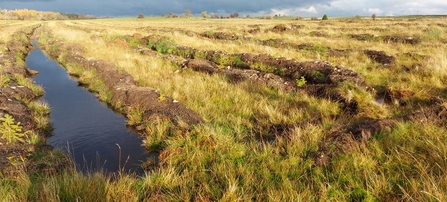
Cumbria Wildlife Trust strongly objects to any planting of trees on peatlands, including at Berrier End, near Penrith (above) © Stephen Trotter

Cumbria Wildlife Trust strongly objects to any planting of trees on peatlands, including at Berrier End, near Penrith (above) © Stephen Trotter
ALL remaining areas of peatland, no matter how small, should be protected from destruction and further impacts or any threats which may cause damage or loss of condition.Stephen Trotter, CEOCumbria Wildlife Trust
Peatlands are extremely valuable because of their importance for wildlife. They also provide a very significant store of carbon in the Cumbrian landscape – and these bogs have the potential to draw down large amounts of carbon in future, to help in the fight against climate change, but only if they are healthy and growing. Peatlands can also help to protect local communities from flooding and help to clean water for human use.
Many of Cumbria’s peatlands, especially the lowland raised bogs, have been destroyed over the last 100-200 years. Most of those the remaining peatlands which survive have been damaged or modified to varying degrees, and are no longer in healthy condition. The key issue affecting many sites is their wetness. A high water table level is critical as the low oxygen levels prevent the function of bacteria and fungi. This means that dead vegetation accumulates as peat, rather than decomposing and rotting.
We estimate that some 30 – 35,000 ha of outstanding peatlands require some form of intervention to restore them to a healthy and functioning condition.
Cumbria Wildlife Trust leads the Cumbrian Peat Partnership which has put more than 4900ha of peatlands into restoration in Cumbria in the last 10 years. The majority of this work has been delivered by us, in partnership with local contractors, local landowners, farmers and commoners, the Environment Agency and Natural England, amongst others.
Much of the restoration activity has been funded by grants from Government (via Defra, Natural England, the Environment Agency and the European Union via its Life+ programme). Independent funders like the Esmée Fairbairn Foundation and National Lottery Heritage Fund also play a vital role in making this vital work happen.
Our policy is that:
1 ALL remaining areas of peatland, no matter how small, should be protected from destruction and further impacts or any threats which may cause damage or loss of condition.
These threats can include:
2 ALL surviving peatlands in Cumbria should be put into restoration and recovery as an urgent priority.
The Trust therefore strongly objects to any planting of trees on peatlands including at Berrier End near Penrith.
We believe that the presence of peatland and other habitat/species conservation issues should be identified in the Forestry Commission’s Environmental Impact Assessment required for any woodland creation proposals. Steps must be taken to protect and avoid any damage to peatlands, in accordance with the UK Government’s long-established Forestry policy.
We ask the Forestry Commission to review its decision in this case and reverse the decision to grant permission for tree planting on the important peatlands and bird breeding habitats at Berrier End.
In addition to the peat issues, this site is one of few curlew breeding sites in this part of Cumbria. This threatened and declining species nests on the ground in open habitats and is unable to breed in or close to forestry plantations. The ground work was conducted in late May, early June - the middle of the breeding season for ground nesting birds. We believe that skylark and meadow pipit had active broods which were destroyed and that curlew were actively nesting in the centre of the ground. Skylark and curlew are both on the Birds of Conservation Concern 4 Red List. We believe the Wildlife and Countryside Act is inadequate for dealing with events such as these, since it requires ‘hard’ evidence of deliberate nest destruction. The chances of finding this after the work was done are very slim.
In an ideal world we would like to see:

Berrier End, near Penrith © Stephen Trotter